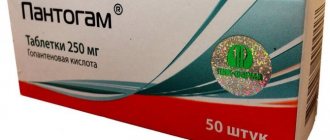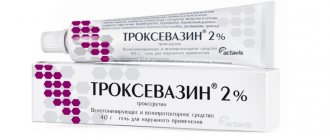Every year, with the constant emergence of a variety of new drugs, harmful microorganisms change, adapt and become increasingly resistant to drugs. Today, it is very common to find bacteria that do not respond to the effects of antibiotics of the erythromycin and penicillin series. For this reason, the pharmacological industry is almost constantly working to create an increasing number of different types of new generation antibiotics, which are synthetic and semi-synthetic improved derivatives of the most well-known antimicrobial and antibacterial agents. Klacidus also belongs to this category.
- Release forms and composition
- Analogs
- When treating children
- During pregnancy and lactation
Description of the drug
A few decades ago, the well-known Erythromycin, which has a lot of very serious disadvantages and side effects, was widely used in medicine to treat pneumonia and various inflammations. Later, based on this substance, semisynthetic Clarithromycin was created, which became the first drug in the class of macrolides. This antibiotic causes much fewer negative reactions and eliminates many of the shortcomings of its predecessor, and, in addition, it is able to act on a wider range of microbes and bacteria. It was on the basis of Clarithromycin, which is the main active ingredient, that Klacid was developed.
Note! Both children and adults can take Klacid, but in different forms. It is prescribed mainly for various ailments of the respiratory system, in particular bronchitis.
The drug shows high effectiveness against harmful bacteria of various categories and types, providing a pronounced bacteriostatic effect, that is, it helps to quickly stop the reproduction and growth of these microorganisms.
The use of Klacid, which is one of the most potent antibiotic agents today, makes it possible to successfully combat a variety of microorganisms not only of the gram-negative category, but also of the gram-positive category, as well as eliminate diseases caused by mycoplasmas, chlamydia and other intracellular parasites that have a fairly strong resistance to antibacterial substances, and various types of cocci.
Release forms and composition
The antibiotic Klacid has several dosage forms, the main substance of which is Clarithromycin, in particular:
A suspension, or rather a special powder for its quick preparation, placed in plastic bottles equipped with a special measuring syringe or spoon. The finished diluted suspension in an amount of 5 ml contains 125 mg of the main substance.- Klacid tablets containing 250 mg of the active substance, coated on top with a special coating and placed in packages of contour cells of 10 and 14 pieces.
- Leophisizate is a powder intended for the preparation of a special solution for drip infusion through a vein. One bottle contains 500 mg of the substance.
Analogs
Analogues of the drug include almost all derivatives of Clarithromycin and products created on its basis, and this list today is very extensive. Most often in pharmacy chains you can find drugs: Fromilid, Clobax, Ecositrin, various types of Azithromycin, Summed, Roxithromycin and others.
Klacid for the treatment of children
In case of inflammatory processes occurring in the child’s body, it is sometimes necessary to use antibiotics. The safest drugs for children are those from the macrolide group, which cause virtually no side effects.
Pediatricians often prescribe Klacid in the form of a suspension to young patients. Thanks to the sweetish taste of the medicine, giving it to your child will not be difficult.
Currently, the medicine is mainly used to treat diseases of the upper and lower respiratory tract caused by pathogenic bacteria entering the body. Children are more susceptible to such ailments, because their immune system is imperfect and cannot work at full strength.
Despite the fact that many parents are against the use of antibacterial agents, it should be borne in mind that in certain situations it is impossible to do without such drugs. When used correctly, the antibiotic has virtually no negative effect on the body.
The powders from which the suspension is prepared are available in several dosages - 125 and 250 mg. Depending on the duration of treatment, you can purchase a bottle of 30, 60 or 100 ml. The prepared suspension is stored for 14 days.
The dosage of the drug is calculated depending on the age and weight of the child (15 mg of clarithromycin per 1 kg of body weight).
Contraindications and side effects
The list of serious contraindications to this remedy, unfortunately, is quite extensive, and it includes:
- simultaneous use of the drug with a number of other drugs,
- the patient has a history of tachycardia, as well as ventricular arrhythmia and prolongation of the QT intervals during an ECG,
- a strong decrease in the level of potassium in the patient’s blood,
- the presence of various forms (especially severe) of renal or liver failure,
- the presence of jaundice that occurred due to previous use of Clarithromycin drugs.
In addition, taking the drug is prohibited during pregnancy, as well as breastfeeding, as well as:
Klacid tablets should not be taken by children under 12 years of age.- Adolescents under 18 years of age are prohibited from taking drip solutions, as well as special tablets labeled CP that have a prolonged action.
- If you have an individual intolerance to Clarithromycin and any drugs based on it.
Klacid SR should not be taken by people who are lactose intolerant or suffer from lactase deficiency.
Contraindications of the relative category, in the presence of which the substance can only be taken with great caution and under the strict supervision of a doctor, include:
- insufficient kidney function and liver function, especially in severe and moderate forms,
- the presence of severe forms of heart failure, bradycardia, ischemic heart disease, hypomagnesemia,
- simultaneous use of drugs with aminoglycoside antibiotics, as well as with drugs of a number of benzodiazepines, with antiarrhythmic drugs and many other drugs, as well as drugs based on St. John's wort.
When using the product, negative reactions can be observed from several systems at once, but most often various digestive disorders occur, for example:
heartburn,- jaundice to varying degrees,
- pain of varying intensity in the abdominal area,
- attacks of vomiting and nausea,
- colitis pseudomembranous type,
- increased liver transaminase.
Manifestations related to the nervous system may also be observed, in particular, insomnia, dizziness, feeling of fatigue, weakness, circles and spots before the eyes, darkening of the eyes with a sudden change in position. With prolonged treatment, fainting is possible. In some cases, allergic reactions of various types and varying degrees of severity may appear, which completely depends on the characteristics of the patient’s body. Most often, an allergy to the drug manifests itself in the form of a normal rash of varying intensity or the appearance of diarrhea, but in allergy sufferers the reaction can be much more serious, up to anaphylactic shock or Quincke's edema.
Klacid®
The use of the following drugs with clarithromycin is contraindicated due to the potential for serious side effects:
Cisapride, pimozide, terfenadine and astemizole
When clarithromycin was co-administered with cisapride, pimozide, terfenadine or astemizole, increased plasma concentrations of the latter were reported, which could lead to QT prolongation and cardiac arrhythmias, including ventricular tachycardia, ventricular fibrillation and torsade de pointes (TdP) (see section "Contraindications").
Ergot alkaloids
Post-marketing studies show that when clarithromycin is used together with ergotamine or dihydroergotamine, the following effects associated with acute poisoning with ergotamine drugs are possible: vascular spasm, ischemia of the limbs and other tissues, including the central nervous system. Concomitant use of clarithromycin with ergot alkaloids is contraindicated (see section “Contra-indications”).
Midazolam for oral use
When midazolam was coadministered with clarithromycin tablets (500 mg twice daily), midazolam AUC increased 7-fold after oral administration. Concomitant use of clarithromycin with oral midazolam is contraindicated (see section "Contraindications").
HMG-CoA reductase inhibitors (statins)
Concomitant use of clarithromycin with lovastatin or simvastatin is contraindicated (see section "Contraindications") due to the fact that these statins are largely metabolized by the CYP3A4 isoenzyme, and combined use with clarithromycin increases their serum concentrations, which leads to an increased risk of developing myopathy, including Rhabdomyolysis Cases of rhabdomyolysis have been reported in patients taking clarithromycin concomitantly with these drugs. If clarithromycin is necessary, lovastatin or simvastatin should be discontinued during therapy.
Clarithromycin should be used with caution in combination therapy with other statins. If coadministration is necessary, it is recommended to take the lowest dose of statin. It is recommended to use statins that do not depend on the metabolism of the CYP3A isoenzyme (for example, fluvastatin). The development of signs and symptoms of myopathy should be monitored.
Effect of other drugs on clarithromycin
Drugs that are inducers of the CYP3A isoenzyme (for example, rifampicin, phenytoin, carbamazepine, phenobarbital, St. John's wort) can induce the metabolism of clarithromycin. This may result in subtherapeutic concentrations of clarithromycin, resulting in reduced effectiveness. In addition, it is necessary to monitor the concentration of the CYP3A inducer in the blood plasma, which may increase due to the inhibition of the CYP3A isoenzyme by clarithromycin. When rifabutin and clarithromycin were used together, an increase in plasma concentrations of rifabutin and a decrease in serum concentrations of clarithromycin were observed with an increased risk of developing uveitis.
The following drugs have a proven or suspected effect on clarithromycin plasma concentrations; if used concomitantly with clarithromycin, dosage adjustments or switching to alternative treatment may be required.
Efavirenz, nevirapine, rifampicin, rifabutin and rifapentine
Strong inducers of the cytochrome P450 system, such as efavirenz, nevirapine, rifampicin, rifabutin and rifapentine, can accelerate the metabolism of clarithromycin and, thus, reduce the concentration of clarithromycin in plasma and at the same time increase the concentration of 14-OH-clarithromycin, a metabolite that is also microbiologically active. Since the microbiological activity of clarithromycin and 14-OH-clarithromycin differs against different bacteria, the therapeutic effect may be reduced when clarithromycin is used together with enzyme inducers.
Etravirine
The concentration of clarithromycin decreases with the use of etravirine, but the concentration of the active metabolite 14-OH-clarithromycin increases. Because 14-OH-clarithromycin has low activity against Mycobacterium
avium complex
(MAC) infections, overall activity against these pathogens may be affected, and alternative treatments should be considered for the treatment of MAC.
Fluconazole
Coadministration of fluconazole 200 mg daily and clarithromycin 500 mg twice daily in 21 healthy volunteers resulted in an increase in mean clarithromycin minimum steady-state concentration (Cmin) and AUC by 33% and 18%, respectively. However, co-administration did not significantly affect the average steady-state concentration of the active metabolite 14-OH-clarithromycin. No dose adjustment of clarithromycin is required when taking fluconazole concomitantly.
Ritonavir
A pharmacokinetic study showed that coadministration of ritonavir 200 mg every eight hours and clarithromycin 500 mg every 12 hours resulted in a marked suppression of the metabolism of clarithromycin. When co-administered with ritonavir, clarithromycin Cmax increased by 31%, Cmin increased by 182% and AUC increased by 77%. Almost complete suppression of the formation of 14-OH-clarithromycin was noted. Due to the wide therapeutic range of clarithromycin, dose reduction is not required in patients with normal renal function. In patients with renal failure, it is advisable to consider the following dose adjustment options: with CC 30 - 60 ml/min, the dose of clarithromycin should be reduced by 50%; with CC less than 30 ml/min, the dose of clarithromycin should be reduced by 75%. Ritonavir should not be co-administered with clarithromycin in doses exceeding 1 g/day.
Similar dosage adjustments should be considered in patients with reduced renal function if ritonavir is used as a pharmacokinetic enhancer when using other HIV protease inhibitors, including atazanavir and saquinavir (see section "Bidirectional Drug Interactions").
Effect of clarithromycin on other drugs
Antiarrhythmic drugs (quinidine and disopyramide)
Ventricular tachycardia of the “pirouette” type may occur with the combined use of clarithromycin and quinidine or disopyramide. When clarithromycin is coadministered with these drugs, the electrocardiogram should be regularly monitored for prolongation of the QT interval, and serum concentrations of these drugs should also be monitored.
During post-marketing use, cases of hypoglycemia have been reported during co-administration of clarithromycin and disopyramide. It is necessary to monitor the concentration of glucose in the blood while using clarithromycin and disopyramide.
Oral hypoglycemic agents/insulin
When clarithromycin is used together with oral hypoglycemic agents (for example, sulfonylureas) and/or insulin, severe hypoglycemia may occur. Concomitant use of clarithromycin with certain hypoglycemic drugs (for example, nateglinide, pioglitazone, repaglinide and rosiglitazone) may lead to inhibition of the CYP3A isoenzyme by clarithromycin, which may result in hypoglycemia. Careful monitoring of glucose concentrations is recommended.
Interactions due to the
CYP3A the
be associated with a mutual increase in their concentrations, which may increase or prolong both therapeutic and side effects. Clarithromycin should be used with caution in patients receiving drugs that are substrates of the CYP3A isoenzyme, especially if these drugs have a narrow therapeutic index (for example, carbamazepine) and/or are extensively metabolized by this enzyme. If necessary, the dose of the drug taken together with clarithromycin should be adjusted. Also, whenever possible, serum concentrations of drugs primarily metabolized by the CYP3A isoenzyme should be monitored.
The following drugs/classes are metabolized by the same CYP3A isoenzyme as clarithromycin, e.g. alprozolam, carbamazepine, cilostazol, cyclosporine, disopyramide, methylprednisolone, midazolam, omeprazole, indirect anticoagulants (e.g. warfarin), atypical antipsychotics (e.g. quetiapine) , quinidine, rifabutin, sildenafil, tacrolimus, triazolam and vinblastine. Also, agonists of the CYP3A isoenzyme include the following drugs that are contraindicated for combined use with clarithromycin: astemizole, cisapride, pimozide, terfenadine, lovastatin, simvastatin and ergot alkaloids (see section “Contraindications”). Drugs that interact in this manner through other isoenzymes within the cytochrome P450 system include phenytoin, theophylline, and valproic acid.
Indirect anticoagulants
When taking warfarin and clarithromycin together, bleeding and a marked increase in INR and prothrombin time are possible. In case of combined use with warfarin or other indirect anticoagulants, it is necessary to monitor the INR and prothrombin time.
Omeprazole
Clarithromycin (500 mg every 8 hours) was studied in healthy adult volunteers in combination with omeprazole (40 mg daily). When clarithromycin and omeprazole were co-administered, steady-state plasma concentrations of omeprazole were increased (Cmax, AUCo-24 and T1/2 increased by 30%, 89% and 34%, respectively). The mean 24-hour gastric pH was 5.2 when omeprazole was taken alone and 5.7 when omeprazole was taken with clarithromycin.
Sildenafil, tadalafil and vardenafil
Each of these phosphodiesterase inhibitors is metabolized, at least in part, by the CYP3A isoenzyme. At the same time, the CYP3A isoenzyme can be inhibited in the presence of clarithromycin. Concomitant use of clarithromycin with sildenafil, tadalafil or vardenafil may result in increased phosphodiesterase inhibitory effects. When using these drugs together with clarithromycin, consider reducing the dose of sildenafil, tadalafil and vardenafil.
Theophylline, carbamazepine
When clarithromycin and theophylline or carbamazepine are used together, the concentration of these drugs in the systemic circulation may increase.
Tolterodine
The primary metabolism of tolterodine occurs through the 2D6 isoform of cytochrome P450 (CYP2D6). However, in part of the population lacking the CYP2D6 isoenzyme, metabolism occurs through the CYP3A isoenzyme. In this population, inhibition of CYP3A results in significantly higher serum tolterodine concentrations. In populations that are poor metabolizers of CYP2D6, a dose reduction of tolterodine may be required in the presence of CYP3A inhibitors such as clarithromycin.
Benzodiazepines (eg, alprazolam, midazolam, triazolam)
When midazolam was co-administered with clarithromycin tablets (500 mg twice daily), midazolam AUC increased by 2.7 times after intravenous midazolam administration. If intravenous midazolam is used concomitantly with clarithromycin, the patient's condition should be carefully monitored for possible dose adjustment. Administration of a drug through the oral mucosa, which bypasses presystemic drug elimination, is likely to result in an interaction similar to that observed with intravenous midazolam rather than with oral administration.
The same precautions should be applied to other benzodiazepines that are metabolized by CYP3A, including triazolam and alprazolam. For benzodiazepines whose elimination is not dependent on the CYP3A isoenzyme (temazepam, nitrazepam, lorazepam), a clinically significant interaction with clarithromycin is unlikely.
When clarithromycin and triazolam are used together, effects on the central nervous system (CNS), such as drowsiness and confusion, are possible. Therefore, if coadministration occurs, it is recommended to monitor for symptoms of CNS impairment.
Interactions with other drugs
Colchicine
Colchicine is a substrate of both CYP3A and the P-glycoprotein (Pgp) transporter protein. It is known that clarithromycin and other macrolides are inhibitors of the CYP3A and Pgp isoenzymes. When clarithromycin and colchicine are taken together, inhibition of Pgp and/or CYP3A may result in increased effects of colchicine. There have been post-marketing reports of cases of colchicine poisoning when taken concomitantly with clarithromycin, most often in elderly patients. Some of the reported cases occurred in patients suffering from kidney failure. Some cases were reported to be fatal. The simultaneous use of clarithromycin and colchicine is contraindicated (see section "Contraindications").
Digoxin
Digoxin is suspected to be a Pgp substrate. Clarithromycin is known to inhibit Pgp. When clarithromycin and digoxin are co-administered, inhibition of Pgp by clarithromycin may result in increased effects of digoxin. Post-marketing studies have shown that coadministration of digoxin and clarithromycin may also result in increased serum concentrations of digoxin. Some patients have experienced clinical symptoms of digoxin toxicity, including potentially fatal arrhythmias. Serum digoxin concentrations should be carefully monitored when clarithromycin and digoxin are coadministered.
Zidovudine
Concomitant use of clarithromycin tablets and oral zidovudine by adult HIV-infected patients may result in decreased steady-state zidovudine concentrations.
Because clarithromycin interferes with the oral absorption of zidovudine, the interaction can be largely avoided by taking clarithromycin and zidovudine 4 hours apart.
This interaction was not observed in HIV-infected children taking clarithromycin pediatric suspension with zidovudine or dideoxyinosine. Since clarithromycin may interfere with the absorption of zidovudine when administered concomitantly orally in adult patients, such an interaction is unlikely to occur when clarithromycin is used intravenously.
Phenytoin and valproic acid
There is evidence of interactions between CYP3A inhibitors (including clarithromycin) and drugs that are not metabolized by CYP3A (phenytoin and valproic acid). For these drugs, when used together with clarithromycin, it is recommended to determine their serum concentrations, as there are reports of their increase.
Bidirectional drug interactions
Ltazanavir
Clarithromycin and atazanavir are both substrates and inhibitors of the CYP3A isoenzyme. There is evidence of a bidirectional interaction between these drugs. Coadministration of clarithromycin (500 mg twice daily) and atazanavir (400 mg once daily) may result in a twofold increase in clarithromycin exposure and a 70% decrease in 14-OH-clarithromycin exposure, with an increase in atazanavirane AUC of 28%. Due to the wide therapeutic range of clarithromycin, dose reduction is not required in patients with normal renal function. In patients with moderate renal failure (creatinine clearance 30 - 60 ml/min), the dose of clarithromycin should be reduced by 50%. In patients with CC less than 30 ml/min, the dose of clarithromycin should be reduced by 75% using the appropriate dosage form of clarithromycin. Clarithromycin in doses exceeding 1000 mg per day should not be used in conjunction with protease inhibitors.
Blockers of "slow" calcium channels
When using clarithromycin simultaneously with blockers of “slow” calcium channels that are metabolized by the CYP3A4 isoenzyme (for example, verapamil, amlodipine, diltiazem), caution should be exercised as there is a risk of arterial hypotension. Plasma concentrations of clarithromycin, as well as slow calcium channel blockers, may increase with simultaneous use. Arterial hypotension, bradyarrhythmia and lactic acidosis are possible when taking clarithromycin and verapamil simultaneously.
Itraconazole
Clarithromycin and itraconazole are substrates and inhibitors of the CYP3A isoenzyme, which determines the bidirectional interaction of the drugs. Clarithromycin may increase plasma concentrations of itraconazole, while itraconazole may increase plasma concentrations of clarithromycin. Patients taking itraconazole and clarithromycin concomitantly should be closely monitored for symptoms of increased or prolonged pharmacological effects of these drugs.
Saquinavir
Clarithromycin and saquinavir are substrates and inhibitors of the CYP3A isoenzyme, which determines the bidirectional interaction of the drugs. Co-administration of clarithromycin (500 mg twice daily) and saquinavir (soft gelatin capsules, 1200 mg three times daily) in 12 healthy volunteers increased the AUC and Cmax of saquinavir by 177% and 187%, respectively, compared with saquinavir administered alone. separately. The AUC and Cmax values of clarithromycin were approximately 40% higher than with clarithromycin monotherapy. When these two drugs are used together for a limited time at the doses/formulations indicated above, no dose adjustment is required. Results from drug interaction studies using saquinavir soft gelatin capsules may not be consistent with the effects observed with saquinavir hard gelatin capsules. The results of drug interaction studies with saquinavir monotherapy may not be consistent with the effects observed with saquinarine/ritonavir therapy. When taking saquinavir with ritonavir, consider the potential effect of ritonavir on clarithromycin.
Can Klacid be used for sore throat?
Tonsillitis can be of either viral or bacterial etiology (distinguished by the presence of white plaque on the tonsils). In the latter case, when streptococcus is a common causative agent of the disease, it is impossible to cope without the help of antibacterial medications. Refusal to use antibiotics risks the development of severe complications in the form of rheumatism, myocarditis, and pyelonephritis.
Treatment of sore throat with Klacid helps eliminate unpleasant symptoms in a short time, which is especially important if a child suffers from the disease. It is prohibited to use the product on your own or change the treatment regimen.
The macrolide antibiotic Klacid is often used in pediatrics due to its high effectiveness against many bacterial infections.
special instructions
Long-term use of Klacid can lead to the development of superinfection, manifested by the growth of fungi and bacteria insensitive to it. For this reason, it is important to perform susceptibility testing, especially in patients with community-acquired pneumonia.
In the presence of chronic liver diseases during therapy, it is necessary to regularly monitor serum enzymes.
If signs of hepatitis appear (abdominal tenderness on palpation, dark urine, jaundice, anorexia, itching), treatment with clarithromycin should be stopped immediately.
There are no data regarding the effect of clarithromycin on the speed of reactions and the ability to concentrate. However, the potential risks of confusion, dizziness and disorientation must be taken into account. Therefore, it is recommended to exercise caution when engaging in potentially hazardous activities and driving vehicles.







